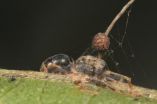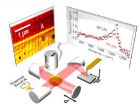(Press-News.org) NASHVILLE, Tenn. – Imagine an insect repellant that not only is thousands of times more effective than DEET – the active ingredient in most commercial mosquito repellants – but also works against all types of insects, including flies, moths and ants.
That possibility has been created by the discovery of a new class of insect repellant made in the laboratory of Vanderbilt Professor of Biological Sciences and Pharmacology Laurence Zwiebel and reported this week in the online Early Edition of the Proceedings of the National Academy of Sciences.
"It wasn't something we set out to find," said David Rinker, a graduate student who performed the study in collaboration with graduate student Gregory Pask and post-doctoral fellow Patrick Jones. "It was an anomaly that we noticed in our tests."
The tests were conducted as part of a major interdisciplinary research project to develop new ways to control the spread of malaria by disrupting a mosquito's sense of smell supported by the Grand Challenges in Global Health Initiative funded by the Foundation for the NIH through a grant from the Bill & Melinda Gates Foundation.
"It's too soon to determine whether this specific compound can act as the basis of a commercial product," Zwiebel cautioned. "But it is the first of its kind and, as such, can be used to develop other similar compounds that have characteristics appropriate for commercialization."
The discovery of this new class of repellant is based on insights that scientists have gained about the basic nature of the insect's sense of smell in the last few years. Although the mosquito's olfactory system is housed in its antennae, 10 years ago biologists thought that it worked in the same way at the molecular level as it does in mammals. A family of special proteins called odorant receptors, or ORs, sits on the surface of nerve cells in the nose of mammals and in the antennae of mosquitoes. When these receptors come into contact with smelly molecules, they trigger the nerves signaling the detection of specific odors.
In the last few years, however, scientists have been surprised to learn that the olfactory system of mosquitoes and other insects is fundamentally different. In the insect system, conventional ORs do not act autonomously. Instead, they form a complex with a unique co-receptor (called Orco) that is also required to detect odorant molecules. ORs are spread all over the antennae and each responds to a different odor. To function, however, each OR must be connected to an Orco.
"Think of an OR as a microphone that can detect a single frequency," Zwiebel said. "On her antenna the mosquito has dozens of types of these microphones, each tuned to a specific frequency. Orco acts as the switch in each microphone that tells the brain when there is a signal. When a mosquito smells an odor, the microphone tuned to that smell will turn "on" its Orco switch. The other microphones remain off. However, by stimulating Orco directly we can turn them all on at once. This would effectively overload the mosquito's sense of smell and shut down her ability to find blood."
Because the researchers couldn't predict what chemicals might modulate OR-Orco complexes, they decided to "throw the kitchen sink" at the problem. Through their affiliation with Vanderbilt's Institute of Chemical Biology, they gained access to Vanderbilt's high throughput screening facility, a technology intended for the drug discovery process, not for the screening of insect ORs.
Jones used genetic engineering techniques to insert mosquito odorant receptors into the human embryonic kidney cells used in the screening process. Rinker tested these cells against a commercial library of 118,000 small molecules normally used in drug development. They expected to find, and did find, a number of compounds that triggered a response in the conventional mosquito ORs they were screening, but they were surprised to find one compound that consistently triggered OR-Orco complexes, leading them to conclude that they had discovered the first molecule that directly stimulates the Orco co-receptor. They have named the compound VUAA1.
Although it is not an odorant molecule, the researchers determined that VUAA1 activates insect OR-Orco complexes in a manner similar to a typical odorant molecule. Jones also verified that mosquitoes respond to exposure to VUAA1, a crucial step in demonstrating that VUAA1 can affect a mosquito's behavior.
"If a compound like VUAA1 can activate every mosquito OR at once, then it could overwhelm the insect's sense of smell, creating a repellant effect akin to stepping onto an elevator with someone wearing too much perfume, except this would be far worse for the mosquito," Jones said.
The researchers have just begun behavioral studies with the compound. In preliminary tests with mosquitoes, they have found that VUAA1 is thousands of times more effective than DEET.
They have also established that the compound stimulates the OR-Orco complexes of flies, moths and ants. As a result, "VUAA1 opens the door for the development of an entirely new class of agents, which could be used not only to disrupt disease vectors, but also the nuisance insects in your backyard or the agricultural pests in your crops," Jones said.
Many questions must be answered before VUAA1 can be considered for commercial applications. Zwiebel's team is currently working with researchers in Vanderbilt's Drug Discovery Program to pare away the parts of VUAA1 that don't contribute to its activity. Once that is done, they will begin testing its toxicity.
Vanderbilt University has filed for a patent on this class of compounds and is talking with potential corporate licensees interested in incorporating them into commercial products, with special focus on development of products to reduce the spread of malaria in the developing world.
###
Visit Research News @ Vanderbilt for more research news from Vanderbilt.
Vanderbilt biologists discover a new class of insect repellent
2011-05-10
ELSE PRESS RELEASES FROM THIS DATE:
Zombie ants have fungus on the brain, new research reveals
2011-05-10
New research has revealed how infection by a parasitic fungus dramatically changes the behavior of tropical of carpenter ants (species Camponotus leonardi), causing them to become zombie-like and to die at a spot that has optimal reproduction conditions for the fungus. The multinational research team studied ants living high up in the rainforest canopy in Thailand. A paper describing the research will be published in the BioMed Central open-access journal BMC Ecology on 9 May 2011.
"The behavior of these infected zombie ants essentially causes their bodies to become an ...
Cheap-TV-Spots.com Tops 190 International Awards for Affordable TV Ads
2011-05-10
The affordable, internet-based TV advertising agency Cheap TV Spots is proud to announce it has won the prestigious Gold Award at the 2011 Worldfest International Film Festival. The advertising agency's amazing award count now stands at over 190 international awards.
Worldfest is the one of the longest running international film and TV festivals in North America, and Cheap-TV-Spots.com is the longest-operating producer of original, discount-priced TV commercials for the international market.
What do all of these awards mean to you, the business owner? Your high quality ...
CIC nanoGUNE develops Nano-FTIR-nanoscale infrared spectroscopy with a thermal source
2011-05-10
Researchers from the Basque nanoscience research center CIC nanoGUNE and Neaspec GmbH (Germany) have developed an instrument that allows for recording infrared spectra with a thermal source at a resolution that is 100 times better than in conventional infrared spectroscopy. In future, the technique could be applied for analyzing the local chemical composition and structure of nanoscale materials in polymer composites, semiconductor devices, minerals or biological tissue. The work is published in Nature Materials.
The absorption of infrared radiation is characteristic ...
Social learning
2011-05-10
Online social networking sites, such as Facebook, can help students become academically and socially integrated as well as improving learning outcomes, according to a study by researchers in China and Hong Kong. Writing in the International Journal of Networking and Virtual Organisations, explain that Facebook usage is around 90% across campuses and many educational institutions offer new students orientation on how to capitalize on social networking to improve their experience of their course and their final results.
Many previous studies of social networking have focused ...
OzeVision Web Hosting Awarded Two Web Hosting Awards In April 2011
2011-05-10
OzeVision Web Hosting has been presented with 14th position amongst the "Top 25 Most Poplar" web hosting companies in the category "Australian Web Hosting Directory" by WebHostDir.com and 5th position in the category "Australian Dedicated Servers Directory" by DedicatedServerDir.com for the month of April 2011. The awards pages can be viewed at:
http://ozevision.com/web_hosting/top-25-most-popular-webhosting-awards.html
http://ozevision.com/web_hosting/top-25-most-popular-dedicated-awards.html
On monthly basis, WebHostDir.com and DedicatedServerDir.com ...
Most nurses don't use recommended intramuscular injection site despite potential risks
2011-05-10
Seven out of ten hospital nurses who took part in a Canadian study used the dorsogluteal (DG) buttock site to administer intramuscular injections - despite the potential risks of sciatic nerve injury - with only 14% using the ventrogluteal (VG) hip site recommended by the nursing literature.
The research, published in the May issue of the Journal of Advanced Nursing, found that younger, newer nurses were significantly more likely to follow the latest VG site advice than their older, experienced colleagues. It also discovered that more than one in four nurses using ...
Study of health in Brazil highlights major progress
2011-05-10
Major progress has been made in reducing the burden of infectious diseases in Brazil as part of a "remarkable" success story for health in the South American country, according to researchers on a series of papers published in The Lancet.
After decades of marked social change, including the introduction of unified healthcare for all, Brazil can also celebrate a reduction in mortality from chronic diseases and huge inroads into improving maternal and child health. But the nation still faces problems – including some infectious diseases such as dengue and leishmaniasis, ...
Blood test for colon cancer screening beneficial for some seniors, but not for many others
2011-05-10
CHAPEL HILL, N.C. – A new study of U.S. veterans ages 70 and older finds that the healthiest get the most benefit from current colon cancer screening methods. However, for many less healthy veterans the burdens of screening may outweigh the benefits.
"This study shows that we really need to target screening in older adults, so that those who will benefit do get screened and followed-up while those who won't benefit aren't exposed to unnecessary burdens," said Christine E. Kistler, MD, assistant professor of Family Medicine at the University of North Carolina at Chapel ...
Hide files within files for better data security
2011-05-10
Steganography is a form of security through obscurity in which information is hidden within an unusual medium. An artist might paint a coded message into a portrait, for instance, or an author embed words in the text. A traditional paper watermark is a well-known example of steganography in action. At first glance, there would appear to be nothing unusual about the work, but a recipient aware of the presence of the hidden message would be able to extract it easily. In the computer age, steganography has become more of a science than an art.
Those intent on hiding information ...
Flying the flag: Does it matter?
2011-05-10
Flying the EU flag on public buildings on Europe Day (Monday, 9th May) has no impact on public attitudes to the EU. But EU symbols used in practical ways such as at airport passport controls can polarise attitudes to the EU amongst the Scots and Welsh, according to a study conducted by researchers at the University of Strathclyde, but have little impact on people in England.
The research suggests that a split in the UK Coalition on whether to fly the EU flag over public buildings in Whitehall ( http://www.bbc.co.uk/news/uk-politics-13321460) would be based on unfounded ...



